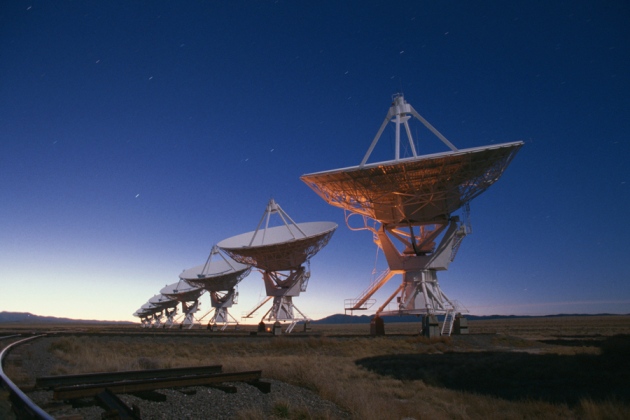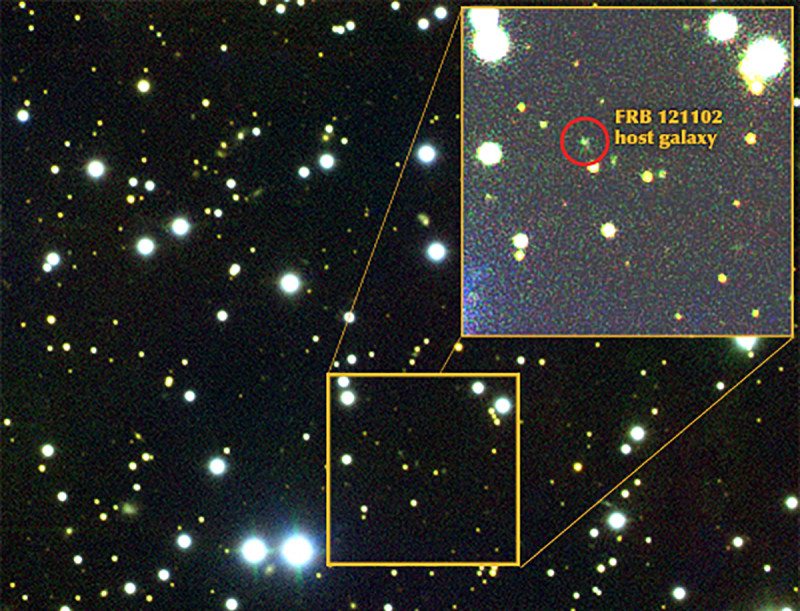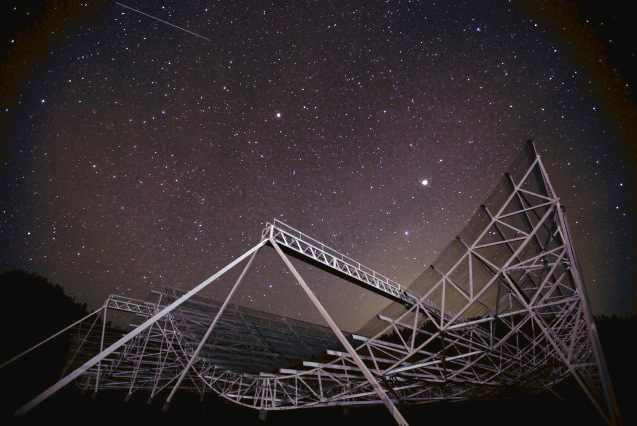For the first time, we have been able to uncover the home of an elusive cosmic signal known as a fast radio burst. These FRBs are energetic blasts of radio waves lasting only thousandths of a second, making them notoriously difficult to pin down. Now a source of FRBs has been found that emits these bursts repeatedly, giving scientists a chance to home in on their signal and figure out exactly where they are coming from.
What they found at the location of the source was a dwarf galaxy described by Shriharsh Tendulkar, an astronomer at McGill University, as “puny”. Although the team of which he is a part of have pinpointed the host of these emissions, questions remain as to what in the dwarf galaxy is causing them. Some had previously proposed that FRBs come from cataclysmic stellar events that destroy the source of the radio burst. Given that this signal, known as FRB 121102, repeats—that can’t hold in this case, but it is possible that FRB 121102 is not typical of FRBs – after all, no others have been observed to repeat. “What we learn from these papers may not be applicable to FRBs more broadly,” argues Peter Williams of the Harvard-Smithsonian Center for Astrophysics.
First spotted in 2007 by the Parkes Observatory in New South Wales, Australia, FRBs have been problematic for physicists because of their infrequent and erratic appearances in telescope data. To date, only 18 distinct FRBs have been seen, but the first six of these were seen only by the Parkes radio telescope, leading some to suggest these signals were nothing more than artefacts of the telescope itself. This changed in 2012 with the first appearance of FRB 121102, spotted at the Arecibo Observatory in Puerto Rico. Since then, researchers have also discovered bursts in old data from the Green Bank Telescope in the US as well as others at Parkes and Arecibo. Nevertheless, their extremely short duration and unpredictable appearances have made FRBs very difficult to study.
FRB 121102’s repeating radio signal was uncovered by PhD student Paul Scholz at McGill University, who was working through data from the Arecibo telescope. His team found ten blasts that seemed to have the same characteristics as the lone FRB121102 signal. However these ten blasts were not enough to pin down the location of the source with a precision that would allow them to associate the repeating signal with anything else, such as a particular galaxy. To do this, the team used a collection of radio telescopes situated all over the world. Shami Chatterjee at Cornell University in Ithaca, New York, spearheaded a campaign using the Karl G. Jansky Very Large Array (VLA) to gather data they could compare with measurements from the Arecibo Observatory. Benito Marcote, of the Joint Institute for VLBI ERIC, led colleagues in searching for FRBs using the European VLBI Network (EVN) in conjunction with the same 305m Arecibo telescope.
Over the course of a several months, they trained their network of telescopes along with Arecibo on the right area of the sky, and looked for the distinctive signals. The joint Arecibo and EVN observations simultaneously detected four bursts from FRB121102. In over 83 hours of VLA observations, the team detected nine bursts from FRB121102, one of which was also found by Arecibo. Using networks of radio telescopes allowed the scientists to locate the source of the signals a thousand times more precisely than they could using only the single dish at the Arecibo Observatory, and these observations were enough to pinpoint the signal with milliarcsecond precision.

The Very Large Array (VLA) in New Mexico was used to pinpoint the source.
Credit: Nature / Roger Ressmeyer / Corbis / VCG / Getty Images
Once they had the exact location, the remaining challenge was to use data from other telescopes to see what could be producing these bursts. The teams had also detected a persistent radio signal coming from the same location as FRB 121102, and searched through data from other experiments to see what they could find at other wavelengths of light. It was data from the Keck telescope taken in 2014 that turned up trumps – they found a bright spot exactly where the home of the FRB should be. Shriharsh Tendulkar then led a set of observations using the Gemini North telescope at Mauna Kea in Hawaii to investigate this visible light coming from the host. The extra data allowed them to pin down and study the dwarf galaxy that was found to be shooting out these radio bursts, and to understand a little about what the enigmatic source might be. There are two possible explanations the team favours. The source of the radio bursts could be an active galactic nucleus – a supermassive black hole, surrounded by a huge disk of gas that spits out energy and radio waves as it is drawn in. Another strong candidate is the remains of a supernova – a cloud of searing hot gas and dust left over from the explosion of a star – being energized by a young neutron star, making the source of FRB 121102 between 100 and 1000 years old.
Although evidence is mounting, the question of what is producing FRB 121102 remains open, and Shami Chatterjee is adamant that their job is not over yet. “Our highest priority for the future is to find one more FRB that repeats,” he says. “Right now we are arguing from a sample of one, which is always a dangerous argument to be making.” A strong hope for the future comes from the long-awaited CHIME radio telescope array, which may have the potential to find thousands of FRBs, giving scientists a chance to better understand these elusive blasts from space.
Sources:
On the discovery of FRB121102: https://arxiv.org/abs/1404.2934
On the first repeating FRB signal: http://www.nature.com/nature/journal/v531/n7593/full/nature17168.html
On pinpointing the source of FRB121102 using the EVN: http://iopscience.iop.org/article/10.3847/2041-8213/834/2/L8
On pinpointing the source of FRB121102 using the VLA: http://www.nature.com/nature/journal/v541/n7635/full/nature20797.html
On finding the host galaxy: http://iopscience.iop.org/article/10.3847/2041-8213/834/2/L7
The CHIME telescope: http://chime.phas.ubc.ca/ http://www.astro.caltech.edu/~ycao/B&ETalks/CHIME_Boutique.pdf
![Source of mysterious cosmic bursts pinpointed For the first time, we have been able to uncover the home of an elusive cosmic signal known as a fast radio burst. These FRBs […]](/wp-content/uploads/2017/01/WEB_GettyImages-527960778_VLA-620x300.jpg)

